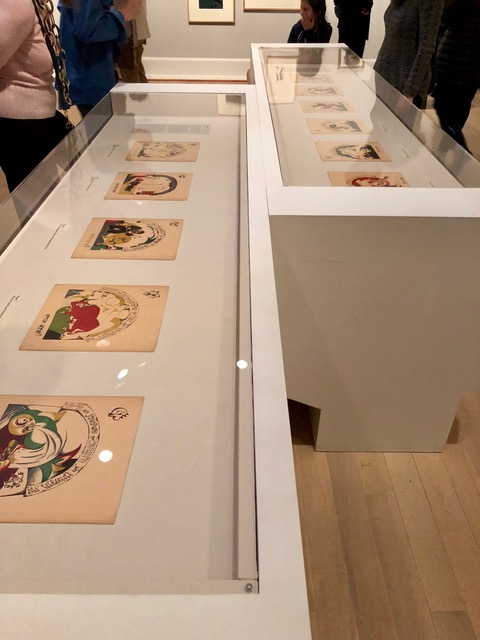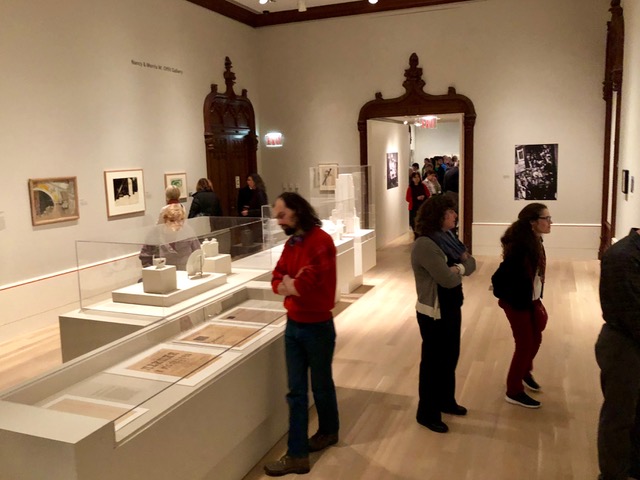Utopia Revisited: Malevich, Chagall, and Lissitzky at the Jewish Museum
A silent video of Vladimir Lenin speaking enthusiastically to Russian crowds greets the visitors of the Jewish Museum’s second floor. We hear no words, but Lenin appears victorious; the footage, we assume, must have been filmed after April 1917, when the exiled leader had just been clandestinely brought back from Switzerland onboard a German train. In the following months, Lenin would successfully lead a revolution that overthrew the tsarist regime and ventured to turn Russia into a communist state. And while it only took a few years for this sense of communist idealism to be swiftly replaced by an authoritarian regime, for a brief moment there was hope that Marxism finally found its fertile ground.

El Lissitzky, Illustrations for Had Gadya from 1919 on view in “Chagall, Lissitzky, Malevich: The Russian Avant-Garde in Vitebsk, 1918-1922” at the Jewish Museum, New York. Image: Courtesy of the author.
It is precisely that short-lived moment of post-revolutionary social, political, and cultural utopia in Russia that the Jewish Museum’s exhibition titled “Chagall, Lissitzky, Malevich: The Russian Avant-Garde in Vitebsk, 1918-1922” addresses (September 14, 2018 – January 6, 2019). The show was a collaborative effort between Angela Lampe from Musée National d’Art Modern in Paris and Claudia J. Nahson from the Jewish Museum, and travelled to New York from Centre Pompidou where it was originally exhibited. The premise of the exhibition revolves around the Vitebsk School of Art, a transformational yet transitory art institution established by Marc Chagall shortly after the Russian Revolution. Its focus—despite showcasing the work of various artists associated with the school, many of whom were of Jewish heritage—is on Chagall’s arguably brief yet nonetheless fruitful encounter with two other Russian artists, Kazimir Malevich and El Lissitzky.
The three main artists featured in the Jewish Museum’s exhibition are, as the wall text explains, rarely seen together. Chagall, who left the Soviet Union for Paris in 1922, is often disassociated from the Soviet Union, despite having established the Vitebsk school. His early figurative idiom, inspired by Jewish and Slavic folk art, was admittedly short-lived, while the work the artist did after having arrived in Paris eschewed the political context typified by the practice of his Russian contemporaries. Similarly, the complex practice of El Lissitzky, who studied first with Chagall and later with Malevich, has seldom been placed against the backdrop of his two teachers.
The contribution of “Chagall, Lissitzky, Malevich” is two-fold. First, it fills a scholarly lacuna in studies of early post-revolutionary avant-garde by illustrating that a shared enthusiasm towards a utopic socio-political vision among Russian modern artists was not—as we are often taught to believe—contingent upon a shared visual vocabulary. Featuring a selection of both abstract and figurative works, it productively complicates one’s approach to the tumultuous period of Russian Civil War, one traditionally dominated by narratives that revolve almost exclusively around the non-objective experiments of Constructivism. Second, the exhibition sheds light on the oft overlooked Jewish renaissance in the early twentieth-century Russia, a cultural phenomenon spurred by the outbreak of the revolution. With Malevich offering a notable exception—he was born to Polish parents who were Roman Catholic—many of the artists working in Vitebsk were of Jewish heritage. Officially recognized as citizens in the aftermath of the October Revolution, these artists went to on to develop secular visual vocabularies largely inspired by their own vernacular culture.(See Seth L. Wolitz, “The Jewish National Art Renaissance in Russia” in Ruth Apter-Gabriel, ed. Exh. cat., (Jerusalem: The Israel Museum, 1987), 21-43.) The exhibition at the Jewish Museum demonstrates how this short-lived burst of Jewish modern art notably contributed to the rise of the Russian avant-garde at large.
Exuberant compositions by Marc Chagall, all created around the time of the school’s establishment in 1918, open the show. Works on paper and oil paintings alike, they seem to carry a sense of visual instability that is characterized by distorted bodies caught in highly unnatural poses. In the amusingly colorful 1917-1918 composition titled Double Portrait with Wine Glass Chagall floats joyfully over Vitebsk carried on his wife Bela’s shoulders, while in the 1919 Man with His Head Thrown Back a peasant is seen tilting his head aggressively backwards. We learn that these and other bodies by Chagall epitomize the upheavals that defined the socio-political of post-revolutionary Russia: “Lenin turned the country upside down,” the artist said, “and I turn my paintings upside down.” Yet, the corporeal movement characterized by these compositions arguably also carried over to the work of other artists, especially that of Chagall’s student El Lissitzky. Lissitzky’s abstract Prouns, which utilized axonometric projection, destabilized the spectator’s field of vision. Tilted and often dismembered, Chagall’s odd figurations were later translated into Lissitzky’s visually confounding abstractions.(While some scholars have noted the influence of Chagall’s work—particularly his series of illustrations titled Chad Gaya that are also on view at the Jewish Museum—on Lissitzky’s Prouns, little attention is generally paid to the ramifications of Marc Chagall’s figurative idiom for his student’s subsequent non-objective oeuvre. (See Bois, 1988).)

Works on display in “Chagall, Lissitzky, Malevich: The Russian Avant-Garde in Vitebsk, 1918-1922” at the Jewish Museum, New York.Image: Courtesy of the author.
The relevance of figurative art for early post-revolutionary Russian culture manifests itself throughout the exhibition in diverse ways. It was refreshing, for instance, to see Yuri Pen’s fairly unknown self-portrait from 1922 exposed prominently in the section detailing the beginnings of the Vitebsk school. A founder of the first private art institution in Vitebsk, Pen was a teacher of several artists, including Chagall and El Lissitzky. In this Rembrant-like likeness, we see Pen’s early attempt at navigating the kind of realistic language that would soon dominate the country and, by 1934, become the only acceptable artistic style in the Soviet Union. Pen’s composition is not a Socialist Realist painting quite yet, although it does raise important questions about the relevance of realist idioms in pre-Stalinist art. Western art history has long pretended—citing the inherent propagandist character of these works—that Socialist Realism was not actually art, although Pen’s portrait prompts one to reconsider such an approach by pointing to the heterogeneity of Russian realist vocabularies. Moreover, it suggests the continued exposure to such idioms by even avant-garde artists.
A 1919 composition titled Art of the Commune by Mikhail Kunin, one of Pen’s early students, offers a different form of early Soviet figuration. Painted during a class taught by Chagall at Vitebsk, it illustrates a set of colorful glassware items in a manner that approximates Cezanne’s disruption of compositional space. An inscription in Cyrillic in the lower left describes the composition as a “leap into the future,” perhaps alluding to the Russian artists’ sustained interest in and exposure to Italian Futurism. But while these two elements seem to draw from the Western tradition, Kunin’s exuberant palette alludes to Malevich’s geometrical vocabulary (while in Vitebsk, he studied under Malevich as well as Chagall). We learn that Kunin was not afraid to criticize Suprematism for its nihilistic approach to art and its supposed destruction of painterly culture, a likely explanation for what one can recognize as the artist’s attempt to turn the colorful abstract planes of Suprematism into everyday objects. Appearing as more than a mere study, Kunin’s work signals the diversity of visual idioms with which artists of the younger generation working in the wake of 1917 Revolution were hoping to satisfy the political needs of their time.
Abstraction reigns in the remainder of exhibition, as Lissitzky’s work gradually reflects his engagement with Malevich’s non-objective vocabulary of Suprematism. Many objects featured in the section dedicated to Lissitzky’s collaboration with Malevich are familiar manifestations of the Suprematist geometrical idiom, including Malevich’s Mystic Suprematism (Red Cross on Black Circle), made sometime between 1920–22 and Lissitzky’s well-known Beat the Whites with the Red Wedge poster from 1919. Nonetheless, the curators’ inclusion of selected archival materials, including Malevich’s handwritten notes and letters relating to On New Systems in Art from 1919, significantly augments the historical context of these seemingly well-known works. Offering an insight into a creative exchange within the institutional framework of the Vitebsk school, these documents sketch out a narrative of intense study and collaboration that reveals a distinctive pedagogical framework of Vitebsk, one demarcated by intense social upheaval on the one hand and unrelenting political idealism on the other.
This collaborative environment, however, was not free from serious conceptual clashes between its members. Malevich’s successful effort to gradually replace Chagall as the leader of the institution manifests itself in the last room of the show, which focuses on the short-lived UNOVIS (Affirmers of the New Art) group founded in 1920 and led by Malevich. In addition to drawings and sketches, the display includes utopian visions of social transformation that range from architectural models of new, Suprematist buildings to china designs, all of which seem to illustrate Malevich’s idealistic attempts to aid in transforming the new Russian society. Stifled by the development of abstraction exemplified by the work of Malevich and his students, Chagall leaves Vitebsk in 1920 and moves to Moscow, finding himself betrayed by the members of his own institution. An oil composition from the same year seemingly alludes to this betrayal, showing a figure of a magician attempting to find his balance among large geometrical shapes that render his efforts unsuccessful. A small image of a goat witnesses the events from afar, its distance signaling that the once exuberant, folk-inspired figuration of Chagall was no longer in vogue.
Despite the wealth of the visual material presented in the exhibition, it is surprising to see a dearth of female artists. While a photograph of students taken some time between 1919 and 1920—which is displayed next to the show’s introductory wall text—counts at least seven women, the works augmenting those of Malevich, Chagall and Lissitzky were in vast majority made by men. Were the efforts of their female counterparts as illustrious as those of female artists in Moscow’s INKhUK? What was their function within the aforementioned intellectual collaborative and how much did they contribute to the institution’s legacy? These and other gender-related questions remain regrettably unanswered, preventing the exhibition from offering a potentially valuable contribution to the important debate regarding female emancipation in early post-revolutionary Russia.
The show concludes in 1922—the year in which the Civil War ended, the school shut down, and the earlier dream of a utopia began to slowly turn into the reality of authoritarianism. The artistic endeavors of the preceding four years reveal how an attempt to construct the country’s visual culture anew, even if ultimately futile, was predicated upon the ideals of collective engagement and cultural inclusion. At a time when discrimination of all kinds is rampant, one ought to recognize the relevance of these two ideals as the exhibition’s most valuable takeaway.



